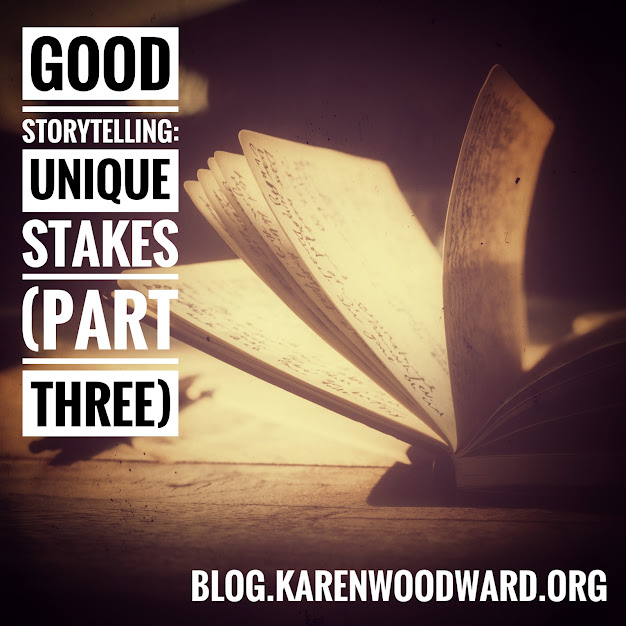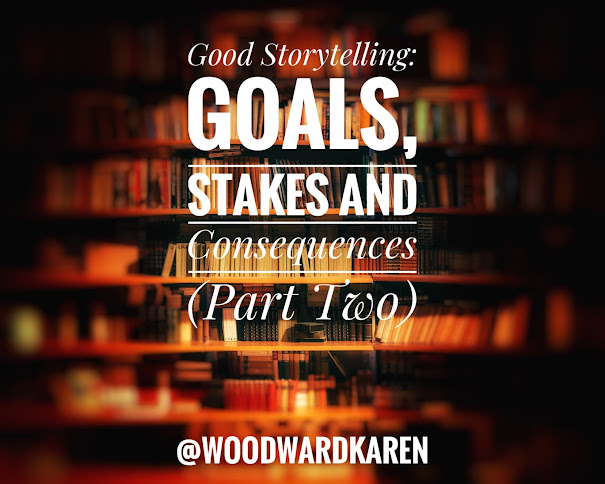My Dad was an amazing storyteller. Because of him, I’ve spent a lifetime thinking about stories, thinking about whether there’s something that great stories have in common.
There is: the hero’s journey. (Also called the monomyth.)
I started blogging about writing in 2010 because I believed that, as Seneca wrote, "by teaching we are learning." My blog grew from that quest.
The sort of stories I focus on are genre stories. Those are the kind of stories that keep decent hardworking folk up until indecent hours, unable to put their book down until they find out what happened, whether the hero or heroine rescued their love, recovered the treasure, saved the day.
The key to writing good genre fiction is to create suspense. Which means creating complex, compelling, characters, putting them in an interesting yet hostile setting, introducing believable opposition with clear stakes, and wrapping it all up in a well thought out plot.
So...simple. ;)
Genre
I know it’s an obvious point, but stories within the same genre have a common structure. An example: for a story to be a murder mystery it must have both a mystery and a murder. There will be a sleuth and they will uncover various clues. Some of these will help the sleuth nab the murderer, some won't. Certain characters will be red herrings and there will be at least one murderer. Finally, and perhaps most importantly, at the end of the story the sleuth will reveal not only the solution of the mystery but how they uncovered the suspects' lies to arrive, finally, at the truth. As a result, order is restored.
Murder mystery stories are a subgenre of mystery stories, but the divisions and subdivisions don't stop there. There are many different kinds of murder mysteries, each with a more demanding set of requirements. A cozy or whodunit (think of Agatha Christie or Dorothy L. Sayers) should have all the above as well as a logical, rational solution. No hocus pocus, no unfounded intuitions. The focus is on the mystery of the murder itself--how it was accomplished--as well as how the sleuth goes about solving the crime. It is crucial that the storyteller plays fair with the reader and tells them everything the sleuth learns as he or she learns it. A hardboiled detective story, on the other hand, often focuses less on the mystery and its solution and more on action and gritty realism.
I'm not going to go through each genre and give a detailed map of reader expectations. What I'm going to do is talk about a structure that is common to all good stories, regardless of genre. At least, that's the plan.
A Three Act Structure
Most stories can be broken into three acts.
Act One—The Ordinary World—First Quarter
Act One is where you introduce your characters and the world they live in. As the story unfolds, readers find out more about the characters as they interact with each other as well as with the world around them, both physical and social. We see their strengths and weaknesses, their hopes and fears, their quirks and idiosyncrasies. The most important character in all this is the hero because the story revolves around his quest. That's what a story is, fundamentally: a description of a character's pursuit of a goal.
The Inciting Incident And The Call To Adventure
The Ordinary World of the hero is static, at least in the beginning. Often, there is something deeply wrong with the hero's normal existence. The hero exists in a state of imperfection. He isn't happy but he's afraid that if he tries to change anything things will get worse.
During the Inciting Incident something happens that changes the hero's world. This change will eventually effect the hero and shatter his status quo. The Inciting Incident creates an imbalance, an inequality, that must be addressed. This is the problem the hero seeks to solve, the wrong he seeks to right, when he answers the Call to Adventure.
For instance, in the movie Shrek the namesake character is an ogre who says he wants to be left alone in his swamp. Of course, what he really wants is for people not to make up their minds about him before they meet him. He wants to forge some sort of connection with others, but he's afraid of being rejected because it happens so often.
When Lord Farquaad exiles legions of fairytale creatures to Shrek's swamp (this is the Inciting Incident), Shrek's solitude is stripped away. This sends Shrek and Donkey off on a mission to confront Lord Farquaad and convince him to send the fairytale creatures somewhere--anywhere--else. But Lord Farquaad has another idea.
Lord Farquaad proposes (this is Shrek's Call to Adventure) that if Shrek conquers the fire-breathing dragon and frees Princess Fiona from her imprisonment in the castle, that he will grant Shrek's wish and clear his swamp. Shrek accepts and, in the process of accomplishing his mission, falls in love with the princess. Now Shrek has another goal, to tell the princess he loves her. What prevents him from doing so is his fear of rejection. This fear is what Shrek has to overcome if he is to achieve his goal and win Fiona's hand in marriage.
The Lock In
At the end of the first act the hero is locked into their quest. He has a moment of realization and understands that if he takes up the quest he must leave his ordinary world behind. It is important that the hero understand the stakes involved and, despite the dismal odds of success, choose to take up the quest knowing that, if they do, there is no going back.
In Shrek, when Lord Farquaad gives Shrek his Call to Adventure, Shrek has a choice: accept or not. But archers perch atop the walls ready to shoot him dead if he refuses. After that, Shrek is locked in to the quest.
In Star Wars when Luke finds his aunt and uncle dead, massacred by storm troopers, he understands there is no going back. His ordinary world is gone.
I think the most obvious case of the Lock In is The Matrix. At the end of Act One Morpheus gives Neo a choice: take the red pill or the blue pill. The red pill will change Neo's entire world and show him the truth he has always searched for. The blue pill will restore the status quo of the Ordinary World. His choice is irreversible.
Act Two—The Special World—The Middle Half
At the end of Act One the hero answers the Call to Adventure and crosses the threshold into the Special World. Here everything is different, strange, reversed. The hero's strength (usually characters have at least one strength) isn't going to serve him as well here, perhaps it even puts him at a disadvantage.
In the first part of Act Two the hero goes through a series of Tests And Trials, most of which he fails, and he makes new acquaintances, both Allies and Enemies. It is also here, at the beginning of Act Two, that the B-story starts. Some of those the hero meets will become his staunch allies and will join his quest while others will become his enemies. This time of Trials and Tests is also a time of Fun and Games. In a movie this is where you often have a feel-good montage.
The first half of Act Two often contains a moment of bonding. If there is a romance, the hero and his love interest may deepen their relationship. After all, the hero is about to confront the villain and, perhaps, pay with his life. If there is no romance, the story will likely still contain a moment of bonding between the hero and their sidekick, a pause, a girding of the loins, as well as a review of the stakes. What will happen if the hero loses? If he wins? Who will it effect?
The Midpoint
Finally, the moment of confrontation has arrived. The Ordeal has begun. Since we know the stakes of the battle we watch anxiously as the hero risks everything to defeat his foe. The confrontation between the hero and his nemesis can be a physical one but it needn't be. Sometimes they are each going after the same item. In the movie Indiana Jones and Raiders of the Lost Ark, Indy loses the ark to Dr. René Belloq, his nemesis. In Star Wars, Luke discovers the Death Star.
Regardless of whether a physical confrontation occurs, the Midpoint represents a sea change in the story. Where before the hero was passive, now he is active. This doesn't occur all at once, but the Midpoint marks the change. Often this change occurs because the hero receives information. This information could be about the villain. It could also be about the nature of the Special World and the villain's--as well as the hero's--place in it.
After the confrontation at the Midpoint the stakes of the battle get cashed out. If the hero is successful, he will get a reward. If the hero isn't successful then usually this is just the beginning of the grief that rains down upon him and those he cares about. Often, if the hero fails at the Midpoint he will also fail at the Climax of the story. Similarly, if the hero wins at the Midpoint he will likely win at the Climax.
Regardless of whether the hero wins at the Midpoint, the stakes go up. Way up. The hero hasn't resolved the conflict, he has increased it. I can't stress this enough. Where before it was only the hero's life at stake now it is also the lives of the hero's allies. Perhaps, by the time we reach the Climax, even the lives of his loved ones back home--as well as, perhaps, the world or even the entire galaxy!--will lie in the balance.
Another important change that occurs around the Midpoint is that now it's not just the villain who is driving the story forward, it's also the hero. You even see this in stories that have a non-traditional structure, stories such as The Usual Suspects.
Disaster
Toward the end of Act Two matters have radically changed, and for the worse. There is often a Major Setback, quickly followed by an All Hope Is Lost moment (or, rather, by a series of them where each is more intense than the one before). As the name implies, something occurs that transforms the hero's world, or his view of it, and brings him to his lowest point.
For instance, in the movie Shrek the Major Setback comes when Shrek overhears Princess Fiona talking with Donkey. Shrek misunderstands who Fiona is talking about and jumps to the mistaken conclusion that Fiona thinks he is ugly and unlovable. Since he was working up the courage to tell Fiona he loved her, this revelation comes as quite a blow.
The All Hope Is Lost moment comes shortly after Shrek is cruel to Donkey. Of course we, the audience, know Shrek is acting as he is because he mistakenly believes Donkey was deriding him. Shrek tells Donkey to go away, that he isn't welcome in his swamp again, ever! This is Shrek's lowest point. As a result of his own actions, Shrek has become estranged from the two people who care about him most.
Act Three—The Return Home—Last Quarter
After the All Is Lost moment the B-story is usually resolved. Because of the way the B-story ends, an important change occurs in the hero and he is able to resolve his inner conflict as well; this often takes the form of an epiphany. The hero then uses this revelation to figure out how to turn matters around and make one last desperate try to achieve his goal.
I don't mean a superhuman ability--though, depending on the kind of story this is, it could be. But whatever it is, the ground must have been laid for it, otherwise it would be a cheat. Perhaps the hero is now, finally, able to think clearly. Perhaps the hero lacked empathy but now understands how other people feel.
Whatever the case, something fundamental within the hero changes and, as a result, he is able to defeat the villain and achieve his goal. (I should mention, though, that not all heroes have an internal conflict. If there is no inner conflict, the hero can draw upon some characteristic that defines him such as his strength or his knowledge. Indiana Jones in Raiders of the Lost Ark is a good example of a hero who lacks any significant internal conflict.)
(Note: Though, having said this, one of my readers quite rightly pointed out that Indiana Jones starts out the movie doubting that the power of the Ark is real. By the end he knows it is. So his is a journey from ignorance to knowledge.)
One way of describing this point in a story, this beat, is that the scales drop from the hero's eyes. He thought he knew how things were, but he didn't. To use Shrek as an example again, the ogre thought he knew how the Princess and Donkey felt about him, but he didn't. He was dead wrong. After the All Hope Is Lost point Donkey comes to Shrek and tells him Fiona wasn't calling him ugly and unlovable. Donkey doesn't tell Shrek she was describing herself because that's not his secret to tell. This is when the proverbial scales fall from Shrek's eyes and he realizes he acted like an idiot. Shrek decides to do what he should have done long before, he decides to risk rejection and ridicule and tell Princess Fiona he loves her.
Here's another example. At the end of The Matrix Neo realizes he's The One, and that he loves Trinity. At that moment the scales drop from his eyes and he sees what he had been blind to. He finally understands and this realization transforms him. It allows him to do something he wouldn't have otherwise been able to do. Neo triumphs over The Matrix and becomes The One.
I'm not suggesting that this life-transforming moment of self-realization occurs at the end of every story. It doesn't. But it happens often enough that I wanted to mention it.
But, of course, the hero doesn't have to win. Sometimes the revelation comes, but too late. Sometimes the revelation doesn't come at all.
Aftermath
In the Aftermath, or Wrap Up, the audience sees the effects of the hero's efforts. How did the hero's Ordinary World change as a result of his adventure? What was his reward? Or, if he failed, what was the cost of his failure? This is where any loose ends are tied up.
Caveat
I don't want to leave anyone with the impression that there's only one story structure. As Chuck Wendig says, every story has a unique structure if looked at in all their particularity. No one can look at the structure of a story and say, "That's wrong!" just because it's different. The bottom line is: If a story works, then it works.
The structure I've talked about, above, is one I've been thinking about and working on for a while now. I think that it describes over 90% of the stories I've read, listened to, or watched; or at least parts of it do. That's because it looks at a story abstractly. It is a web of generalizations and so is almost guaranteed to get something right!
As I write I like to think about the structure of the story I'm working on and make it explicit. Often, if I feel something is wrong with a story but I just can't put my finger on it, I go back to basics and study various story structures in an attempt to puzzle out what the problem is. I think that's the bottom line. If something helps you, use it, if it doesn't, ignore it. Let your own sense of what is right for you be your guide.
Recommended Reading
Talking About Detective Fiction, by P.D. James.
Storyville: What is Literary Fiction? by Richard Thomas over at litreactor.com.
Le Guin’s Hypothesis, at Book View Cafe by Ursula K. Le Guin.
On Serious Literature, by Ursula K. Le Guin.
How To Write A Murderously Good Mystery
How To Write Like Agatha Christie
Agatha Christie's Secret: Break The Rules.










